
Original Link: https://www.anandtech.com/show/2737
Lab Update - Patriot Memory Viper Series DDR3-1333
by Gary Key on March 17, 2009 11:30 PM EST- Posted in
- Memory
As·sump·tion - an assuming that something is true; a fact or statement (as a proposition, axiom, postulate, or notion) taken for granted. A very powerful word if we might say so and one that can generally get us in trouble while reviewing hardware. During the course of testing for our upcoming DDR3 roundup, we assumed a few items to be true about the memory we were reviewing. Turns out, our assumptions were off the mark, but for good reason.
Our first assumption is that we should concentrate on the DDR3-1600 kits as they provided a wide range of flexibility for most users. Most of the performance oriented kits would easily hit DDR3-1800+ at decent timings and voltages, satisfying the overclocking needs of all but the hardcore enthusiasts while at the same time allowing very tight timings at lower clock speeds for applications that responded best to a combination of bandwidth and low latencies.
The reason for choosing DDR3-1600 first is that the initial DDR3-1066 and DDR3-1333 6GB kits we received generally clocked about 100MHz~200MHz above their rated speeds and latency improvements required voltages above 1.65V in most cases on our i7 platform. In addition, pricing was not that much less on a per Gigabyte basis, which certainly justified our higher performing selections at the time. By chance, we were looking at 6GB kit prices on Newegg and NCIX last month and noticed a couple of DDR3-1333 6GB kits had dropped below the $100 mark (a virtual flood of 6GB kits are now hitting the $100 mark).
These kits were not available when we started collecting review samples a few weeks ago so we ordered a new Patriot Viper DDR3-1333 (PVT36G1333ELK) 6GB kit for a very reasonable price of $93.99 plus free shipping. Our reason was simple, we just wanted to see how well the latest “budget” DDR3 product on the market clocked and if our assumptions were still correct about the first 1066/1333 kits we received. Considering our test results with the Patriot kit, we checked the credit line and ordered several “budget” 6GB kits from GSkill, Mushkin, Crucial, OCZ, Corsair, and others to feature in our roundup.
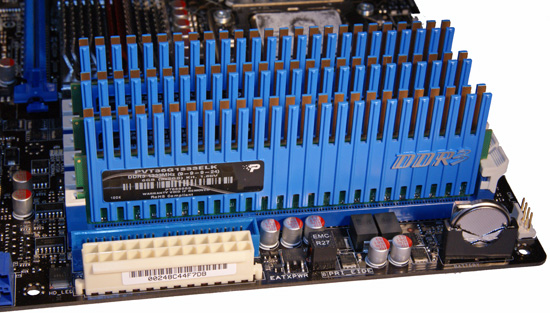
We based our second assumption on test results with our DDR3-1600 to DDR3-2000 kits providing the best possible performance on the i7 platform, especially for those overclocking the 920 processors. Our reasoning for sticking with the higher end kits was sound until recent events. The i7 platform was an expensive proposition for most users who wanted to upgrade with decent motherboards costing $300, the “budget” 920 processor going for nearly $300, and 6GB low voltage DDR3 kits costing a good $225 or higher for products that could keep up with the 920 overclocks. This resulted in a very niche market condition and one that if you had to ask the price then you probably were not going to be able to afford it.
A few weeks later, we have X58 motherboards selling for $170 with rebates, a new i7 processor stepping (D0) coming from Intel that promises a little extra headroom in clock rates, and 6GB DDR3 kits selling for around $90. The entry cost to get into an i7 platform has dropped about 34% in the last six weeks if you are pinching pennies like most of us. Guess what, the performance difference in platform selections then and now is less than 2% at best. Only those who plan on serious overclocking need to worry about spending more, but that is always the case.
Another factor in dropping prices is the rise from ashes act that AMD has accomplished with the Phenom II product line. True, it is not in the same performance category as the i7 when it comes to crunching numbers or heavy manipulation of digital content, but the Phenom II is extremely competitive on a price/performance basis when looking at the big picture. Pairing up the current Phenom II X3 720BE with either a DDR2/DDR3 based 790FX/GX motherboard results in some of the best bang for the buck performance you are likely to experience this year, at least until the new X4 95x series comes out.
Of course, Intel has the P55 platform launching later this year and we mention that because DDR3 will soon become the memory of choice for anyone upgrading to a new platform. The Phenom II platform lets you retain your current DDR2 based AM2+ setup until you decide to make the switch and we will soon see that is not a bad option from an everyday performance or cost viewpoint. However, those who need the absolute best performance from the Phenom II should go the DDR3 route at this point.
All that said, we are here today to take a first look at the Patriot Viper Series (PVT36G1333ELK) DDR3-1333 CAS9 6GB memory kit. Heresy, one might claim looking at the specs but this kit delivers the flexibility we have been seeking, only at a lower price point. Until we finish testing our recent "budget" arrivals, we thought it prudent to provide a quick look at how well this particular memory kit clocks and if it higher memory speeds actually matter at stock processor speeds or mild overclocks.
Test Setup -
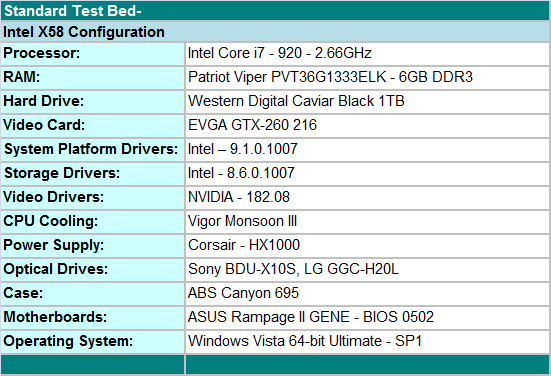
Our test setup is rather vanilla compared to most i7 systems, but we feel like it represents a good median for this platform. The Corsair HX1000 power supply is probably overkill but we have been using it as the standard power supply for our overclocking and multi-GPU adventures. We have not had any problems running this setup with our PC Power & Cooling 610W Silencer (single card) or the Thermaltake Toughpower 850W (SLI/CF) units.
Our motherboard is the new ASUS Rampage II GENE that offers all of the goodness of the X58 chipset in an uATX form factor. The processor of choice is the Intel i7 920 that will be tested at the stock 2.66GHz clock speed and at a 4GHz which is the limit of our air cooling solution from Vigor. Our video card of choice is the EVGA GTX 260 Core 216 that provides a great gaming experience at our 1680x1050 and 1920x1200 test resolutions. Western Digital’s excellent Caviar Black 1TB handles storage duties with the Sony BDU-X10S and LG GGC-H20L taking care of our optical storage needs. Finally, we wrap it all up in the ABS Canyon 695 case and then toss in the star of today’s show, the Patriot Viper Series (PVT36G1333ELK) DDR3-1333 CAS9 6GB memory kit.
Since this is a first look, we are utilizing a very small subset of benchmarks from the upcoming DDR3 roundup. We will take a brief look at the Everest Memory Benchmarks and then move on to FarCry 2 along with the TV/Movies and Productivity test suites from PCMark Vantage. PCMark Vantage does a very good job of providing consistent benchmark results with simulated workloads in actual applications. However, our roundup will also include applications ranging from Autodesk AutoCad 2009 64-bit to Sony Vegas Pro 8.1. Our goal is to provide actual platform results in real applications or games, not trying to get the best SuperPI 32M or 3DMark scores.
Everest –
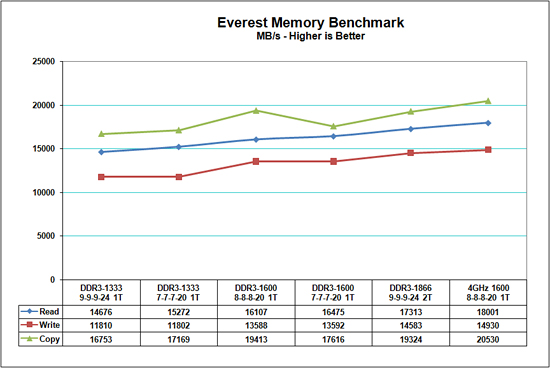
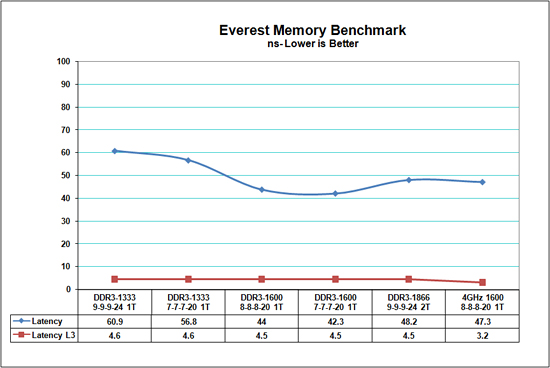
The Everest Read/Write/Copy benchmarks show scaling rates that we expected based on the memory timings utilized. We set the main four memory timings along with the command rate and let the BIOS auto configure the sub-timings. Optimizing the sub-timings will generally net another percent or two in performance, but we feel like ASUS has done an excellent job in extracting about 95%~97% of possible performance out of the memory sub-timings so we left them alone.
However, we did not notice tRRD, tRC, tFAW, and tRFC timing rates being relaxed several percent higher on this memory kit compared to the DDR3-1600 kits when we tightened tCL (CAS), tRCD, tRP, and tRAS timings at DDR3-1333/1600 to improve latencies. This resulted in lower Copy rates at DDR3-1600 and write rates that are equal at 1333/1600 clock speeds. Latency rates followed a similar pattern with DDR3-1600 7-7-7-20 1T offering the best overall latencies although DDR3-1600 8-8-8-20 1T was not too far behind.
We reached a final memory clock speed of DDR3-1866 with timings set to 9-9-9-24 2T at stock CPU speeds (133x20). This required VCore to be set to 1.24375V, VDimm to 1.72306V, and VTT to 1.38750V for 24/7 stability. Our overclock setting resulted in a CPU core speed of 4GHz (200x20) with VCore at 1.45000V (not exactly the best retail unit and this is the clock limit with air cooling for 24/7 use). Memory was set to DDR3-1600 at 8-8-8-24 1T timings with VDimm at 1.65681V and VTT at 1.37500V. Patriot recommends that VTT not be higher than 1.40V and VDimm at 1.75V on this particular kit.
Not listed in our benchmarks today is the best clock speed and timing rates that this memory kit could handle when pushing BCLK up with all eight threads active. We reached a final core clock speed of 3.97GHz (221x18) with VCore at (you guessed it) 1.45000V. Memory clock speed was DDR3-1766 at 9-9-9-24 1T timings on 1.72306V for VDimm and VTT set to 1.39375V.
We have included a set of image galleries below that contain our Everest and CPUZ results along with the base voltages (VCore, VDimm, VTT) utilized for each setting. We will discuss these results and others in greater detail shortly.
Benchmarks –
Far Cry 2
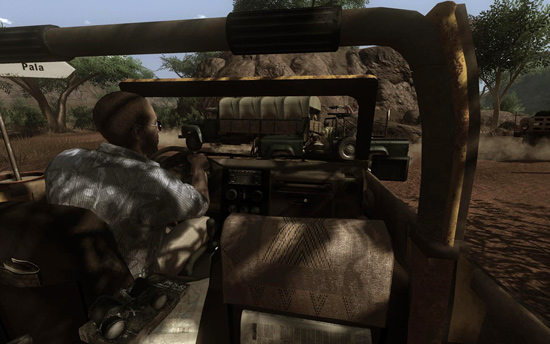
This highly awaited title from last year has beautiful graphics, an open ended environment, and is fun to play... but the traveling between missions tends to get repetitive. If you dial up the graphics options, the game rewards with you some fantastic visuals courtesy of the Dunia Engine. The game also features the most impressive benchmark tool we have seen in a PC game. We set the performance feature set to Very High, graphics to High, and enable DX10 with AA set to 2x. The in-game benchmark tool is utilized with the Ranch Small level.
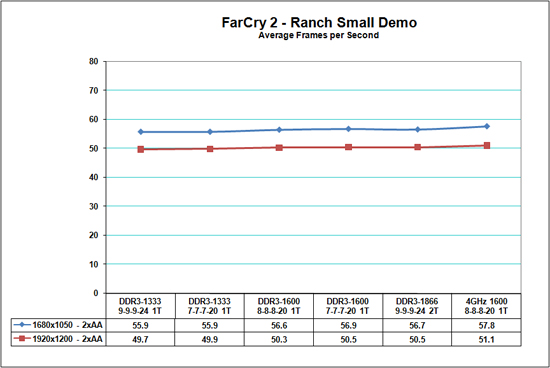
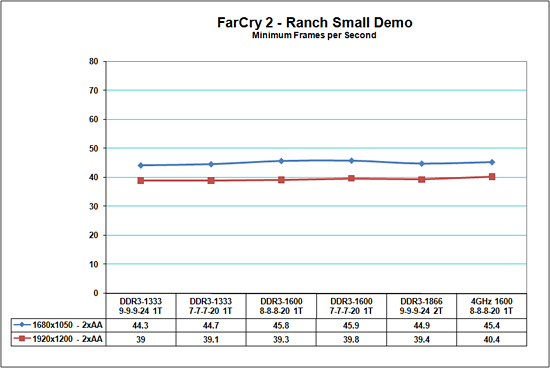
In both the average and minimum frame rate results we notice scaling rates around 1% going from DDR3-1333 C9 to DDR3-1866 C9. At stock CPU and GPU speeds, improving memory timing rates and speeds just does not matter with our particular platform. In fact, overclocking the system only results in a 3% improvement in average frame rates and 2% in minimum rates. Our GPU selection in this benchmark is the leading performance factor for determining frame rates. We had similar results in other games and only the Source based games like Left 4 Dead showed improvements above FarCry 2.
PCMark Vantage: TV and Movies -
This particular test suite concentrates on video transcoding and playback with simultaneous threads. It is one of the more demanding tasks in our test suite and results are dependent on CPU efficiency, core count, and memory bandwidth along with a fast storage system.
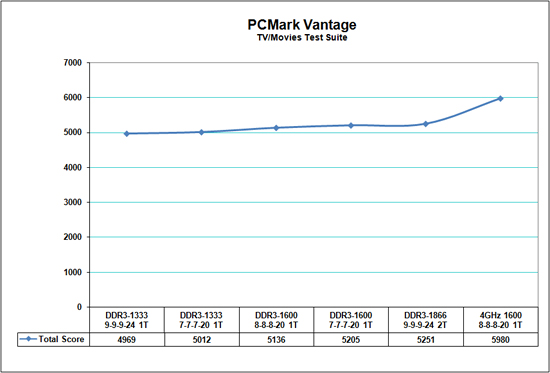
Scaling is linear as we increase memory speed and improve latencies with our best results occurring at DDR3-1866, at least until we overclock the system. The DDR3-1866 result is 5.6% better than our base DDR3-1333 C9 score. Improving our timings and latencies at 1333/1600 resulted in a 1% or so improvement, certainly nothing that would ever be noticed in actual usage.
PCMark Vantage: Productivity -
The productivity test suite focuses on general workloads in an office environment such as word processing, contact searches, email, web page rendering, and malware scanning. It also features simultaneous thread testing and is dependent on CPU speed, memory bandwidth, and a fast storage system.
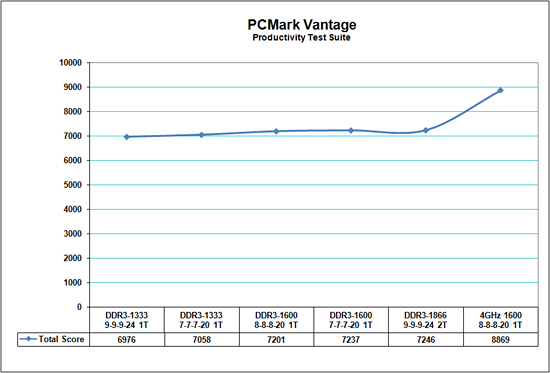
Scaling is similar to the TV/Movies test suite with our best results occurring at DDR3-1866 until we overclock the system. The DDR3-1866 result is 3.8% better than our base DDR3-1333 C9 score and is not noticeable in actual usage. Improving our timings and latencies at 1333/1600 resulted in almost no improvement.
Quick Thoughts -
The Patriot Viper Series (PVT36G1333ELK) DDR3-1333 CAS9 6GB memory kit surprised us with its ability to scale memory speeds up to DDR3-1866 effortlessly or to operate at tight timings with very safe voltage settings. Even with the platform overclocked, the memory had no problems operating at DDR3-1600/1766 with reasonable timings and voltages.
While certainly not a memory kit that an enthusiast would need to break SuperPI or 3DMark records, it would suffice for about 95% of users needing a solid and high quality DDR3 6GB memory kit. Current pricing at Newegg shows this kit to be available for $97.99 with a $15 mail-in-rebate bringing the cost down to $82.99 with free shipping. Just to make sure we did not receive a “cherry” kit the first time from Newegg, we ordered a second kit a week later and had the exact same results with it. As such, we have no qualms about recommending this kit based on price, performance, and customer support provided by Patriot Memory.
We will not delve into our test results until the roundup. We will say that the majority of application benchmarks we have completed to date have resulted in similar patterns provided today at stock processor speeds with a single GPU. However, there is a place for high performance DDR3 memory. We will discuss and show results where it becomes an advantage shortly. In the meantime, a memory kit like the one previewed today will work just fine for most of us.




























